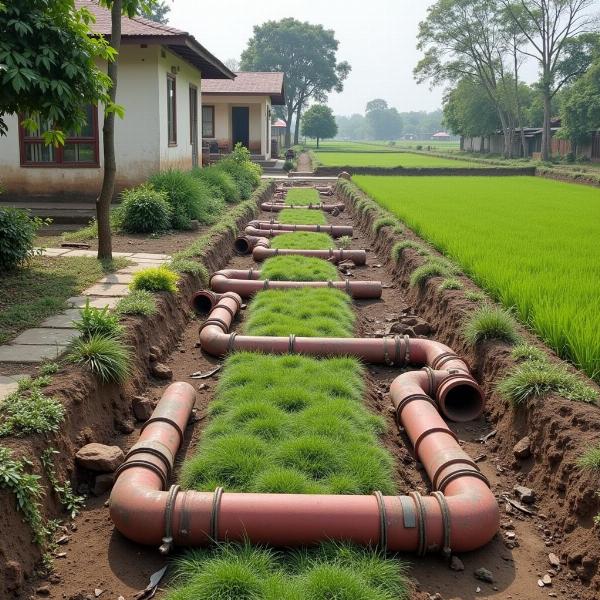Understanding the meaning of “ducts” in Hindi is crucial for various applications, from technical translations to everyday conversations. While a simple translation might suffice in some cases, grasping the nuances and context-specific meanings is essential for accurate communication. This article explores the various Hindi translations of “ducts,” delving into their specific applications and providing practical examples to solidify your understanding.
Different Hindi Words for “Ducts” and Their Uses
The Hindi translation of “ducts” depends heavily on the context. Here’s a breakdown of the most common translations:
- नलिका (Nalikā): This is the most general term for “duct” and can refer to a tube or pipe-like structure that carries fluids or air. It’s often used in biological contexts, such as referring to tear ducts (अश्रु नलिका – ashru nalikā) or bile ducts (पित्त नलिका – pitta nalikā). It can also be used for artificial ducts like air conditioning ducts.
- वाहिनी (Vāhinī): This term often implies a larger duct or channel, frequently used for carrying water or other liquids. Think of irrigation canals (सिंचाई वाहिनी – sinchāī vāhinī) or even blood vessels (रक्त वाहिनी – rakta vāhinī).
- नली (Nalī): Similar to nalikā, but sometimes used for smaller, more flexible tubes or pipes. It can also refer to a hose or a tube-like structure in machinery.
- प्रणाली (Praṇālī): This word refers to a “system” of ducts or channels. For example, the ventilation system of a building can be referred to as वेंटिलेशन प्रणाली (ventileshan praṇālī).
Understanding the Context: Choosing the Right Hindi Word
Choosing the right Hindi word for “ducts” is crucial for clear communication. For instance, if you’re discussing the human body, नलिका (nalikā) would be appropriate. However, when discussing irrigation, वाहिनी (vāhinī) would be more accurate. Consider these examples:
- “The air conditioning ducts need cleaning.” – एयर कंडीशनिंग की नलिकाओं को सफाई की जरूरत है। (Ear kanḍīshaning kī nalikāon ko safāī kī zarūrat hai.)
- “Blocked tear ducts can cause watery eyes.” – अवरुद्ध अश्रु नलिकाएं आंखों में पानी आने का कारण बन सकती हैं। (Avaruddh ashru nalikāen aankhon mein pānī aane kā kāran ban saktī hain.)
- “The irrigation ducts bring water to the fields.” – सिंचाई वाहिनी खेतों में पानी लाती है। (Sinchāī vāhinī kheton mein pānī lātī hai.)
Technical and Specialized Uses of “Ducts” in Hindi
In technical fields, the precise Hindi translation of “ducts” becomes even more critical. For instance, in engineering, नलिका (nalikā) or नली (nalī) are commonly used depending on the size and function of the duct. In medical contexts, specific terms like अश्रु नलिका (ashru nalikā) for tear ducts or पित्त नलिका (pitta nalikā) for bile ducts are essential.
Why Accurate Translation Matters
Accurate translation of “ducts” in Hindi is vital for effective communication in various scenarios, from technical manuals to medical diagnoses. Using the wrong word can lead to misunderstandings and even errors.
Imagine trying to explain a plumbing issue using वाहिनी (vāhinī) when you actually mean the smaller pipes within a house. The plumber might misinterpret your description, leading to wasted time and effort. Similarly, in medical contexts, incorrect terminology can have serious consequences.
“Understanding the cultural and linguistic nuances is paramount in accurate translation,” says Dr. Anita Sharma, a renowned Hindi linguist. “Especially with a word like ‘ducts,’ whose meaning varies greatly depending on the context, precise translation ensures clear and effective communication.”
 Irrigation Ducts
Irrigation Ducts
Conclusion
Finding the right Hindi word for “ducts” requires a nuanced understanding of the context. Whether you’re discussing anatomy, engineering, or everyday objects, using the appropriate term ensures clear and accurate communication. This article provides a solid foundation for choosing the correct Hindi translation, empowering you to navigate various situations with confidence.
FAQ
-
What is the most common Hindi word for “ducts”? नलिका (Nalikā) is the most general and commonly used term.
-
What is the difference between नलिका (Nalikā) and वाहिनी (Vāhinī)? While both refer to ducts, वाहिनी (Vāhinī) typically implies a larger channel, often used for carrying water or other liquids, whereas नलिका (Nalikā) is more general and can refer to smaller tubes as well.
-
How do I choose the correct Hindi word for “ducts”? The context is crucial. Consider what the duct is carrying and its size to select the most appropriate term.
-
Why is accurate translation important? Accurate translation prevents misunderstandings, especially in technical or medical contexts.
-
Where can I find more information about Hindi translations? Meaning-Hindi.in provides expert translation services for various needs.
Meaning-Hindi.in offers professional Hindi translation services, specializing in various domains from business and legal documents to technical manuals and website localization. Our team of expert linguists ensures accurate and culturally sensitive translations. Contact us today for all your Hindi translation needs at [email protected] or call us at +91 11-4502-7584. Meaning-Hindi.in is your trusted partner for bridging language barriers.